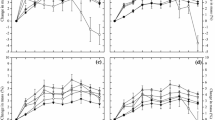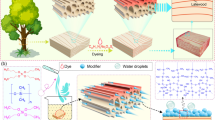Abstract
The effects of copper monoethanolamine (CuA) treatment of wood surfaces on the surface weathering and durability of a semitransparent penetrating stain were compared with those of chromic acid (CrA) treatment which is known as a photoprotective primer, using artificial weathering trials. Chemical changes in chemically treated and untreated wood surfaces during artificial weathering were investigated using Fourier transform infrared (FTIR) spectroscopy. Surface roughness, water contact angle measurements and scanning electron microscopy observations were performed to assess stain durability. Results of FTIR analyses indicated that lignin losses following CuA and CrA treatment were less than those of the untreated wood surfaces during the initial stage of artificial weathering. CuA pretreatment prior to staining also retarded the increase in the average surface roughness compared with that observed for the CrA-pretreated surface and untreated control (only stained) during artificial weathering. Furthermore, CuA pretreatment retarded the decrease in the contact angle compared with that observed for the untreated control, although the use of a highly concentrated CuA solution led to a decrease in the water repellency of the stained wood surface. These results indicated that CuA solution could be used for the pretreatment of wood surfaces to enhance the durability of semitransparent penetrating stains, as long as excessive CuA concentrations are avoided.








Similar content being viewed by others
References
Anderson EL, Pawlak Z, Owen NL, Feist WC (1991) Infrared studies of wood weathering. Part I: softwood. Appl Spectrosc 45(4):641–647
Baur SI, Easteal AJ (2014) ESR studies on the free radical generation in wood by irradiation with selected sources from UV to IR wavelength regions. Holzforschung 68:775–780
Black JM, Mraz EA (1974) Inorganic surface treatments for weather-resistant natural finishes. USDA For Serv Res Pap FPL 232:1–40
Chang ST, Wang SY, Su YC (1998) Retention of red color in Taiwania (Taiwania Cryptomeriodes Hay.) heartwood. Holzforschung 52:13–17
Collier WE, Schultz TP, Kalasinsky VF (1992) Infrared study of lignin: reexamination of aryl-alkyl ether C–O stretching peak assignments. Holzforschung 46:523–528
Cornfield JA, Hale M, Fettis G (1994) A comparison of analytical and visual techniques used for assessment of weathering properties of chromium and copper azole treated timber. Int Res Gr Wood Preserv IRG/WP 94–20023
Craciun R, Kamdem PD (1997) XPS and FTIR applied to the study of waterborne copper naphthenate wood preservatives. Holzforschung 51:207–213
Dawson BSW, Singh AP, Kroese HW, Schwitzer MA, Gallagher S, Riddiough SJ, Wu S (2008) Enhancing exterior performance of clear coatings through photostabilization of wood. Part 2: coating and weathering performance. J Coat Technol Res 5:207–219
Degroot WF (1985) Preliminary investigation of the association of inorganic cations with carboxylic acid groups in wood. Carbohydr Res 142:172–178
Deka M, Humar M, Rep G, Kričej B, Šentjurc M, Petrič M (2008) Effects of UV light irradiation on colour stability of thermally modified, copper ethanolamine treated and non-modified wood: EPR and DRIFT spectroscopic studies. Wood Sci Technol 42:5–20
Ebe K, Kataoka Y, Kiguchi M (2011) Evaluation of weatherability of finished wood by surface roughness. Mokuzai Hozon 37:122–129 (in Japanese with English summary)
Evans PD, Schmalzl KJ (1989) A quantitative weathering study of wood surfaces modified by chromium VI and iron III compounds. Part 1. loss in zero-span tensile strength and weight of thin wood veneers. Holzforschung 43:289–292
Evans PD, Michell AJ, Schmalzl KJ (1992) Studies of the degradation and protection of wood surfaces. Wood Sci Technol 26:151–163
Evans PD, Thay PD, Schmalzl KJ (1996) Degradation of wood surfaces during natural weathering. Effects on lignin and cellulose and on the adhesion of acrylic latex primers. Wood Sci Technol 30:411–422
Evans PD, Owen NL, Schmid S, Webster RD (2002) Weathering and photostability of benzoylated wood. Polym Degrad Stab 76:291–303
Feist WC (1988) Role of pigment concentration in the weathering of semitransparent stains. For Prod J 38:41–44
Grelier S, Castellan A, Kamdem D (2000) Photoprotection of copper-amine-treated pine. Wood Fiber Sci 32:196–202
Grüll G, Tscherne F, Spitaler I, Forsthuber B (2014) Comparison of wood coating durability in natural weathering and artificial weathering using fluorescent UV-lamps and water. Eur J Wood Wood Prod 72:367–376
Harrington KJ, Higgins HG, Michell AJ (1964) Inflared spectra of Eucalyptus regnans F. Muell. and Pinus radiata D. Don. Holzforschung 18:108–113
Hon DNS, Chang ST (1985) Photoprotection of wood surfaces by wood-ion complexes. Wood Fiber Sci 17(1):92–100
Isaji S (2015) Correlation between natural and accelerated weathering of coated wood used in a cold region. J Japan Coat Technol Assoc 50:44–53 (in Japanese with English abstract)
JIS B 0601 (2013) Geometrical product specifications (GPS) -surface texture: profile method-terms, definitions and surface texture parameters. Japanese Standard Association, Tokyo (in Japanese)
JIS K 5600-7-7 (2008) Testing methods for paints-Part 7: Long-period performance of film- Section 7: Accelerated weathering and exposure to artificial radiation (Exposure to filtered xenon-arc radiation). Japanese Standard Association, Tokyo (in Japanese)
Kamdem DP, Grelier S (2002) Surface roughness and color change of copper-amine treated red maple (Acer rubrum) exposed to artificial ultraviolet light. Holzforschung 56:473–478
Kataoka Y, Ishikawa A, Kobayashi M, Matsunaga M, Matsunaga H, Kiguchi M (2015) Weatherability of sugi (Cryptomeria japonica D. Don) sound barriers -Enhanced performance of coatings applied on preservative-treated wood-(in Japanese with English abstract). Mokuzai Hozon 41:62–70
Kiguchi M, Kataoka Y, Doi S, Mori M, Hasegawa M, Morita S, Kinjo M, Kadegaru Y, Imamura Y (1996) Evaluation of weathering resistance of the commercial pigmented stains by outdoor exposure test in Japan. Mokuzai Hozon 22:150–158 (in Japanese with English summary)
Kiguchi M, Kataoka Y, Doi S, Mori M, Hasegawa M, Morita S, Kinjo M, Kadegaru Y, Imamura Y (1997) Improvement of weather resistance of film-forming type clear finishes by pre-treatment with PEG and influence of exposure test sites. Mokuzai Hozon 23(4):168–175 (in Japanese with English summary)
Kiguchi M, Evans P, Ekstedt J, Williams R, Kataoka Y (2001) Improvement of the durability of clear coatings by grafting of UV-absorbers on to wood. Surf Coat Int Part B Coat Trans 84:263–270
Liu R, Ruddick JNR, Jin L (1994) The influence of copper (II) chemicals on the weathering of treated wood, Part I. ACQ treatment of wood on weathering. Int Res Gr Wood Preserv IRG/WP94-30040
Michell AJ (1993) FTIR spectroscopic studies of the reactions of wood and of lignin model compounds with inorganic agents. Wood Sci Technol 27:69–80
Nejad M, Cooper P (2011) Exterior wood coatings. Part-1: performance of semitransparent stains on preservative-treated wood. J Coat Technol Res 8:449–458
Ohtani K (1987) Chromium trioxide enhances the durability of wood doors. Chromium Rev 8:4–7
Olsson SK, Johansson M, Westin M, Östmark E (2014) Reactive UV-absorber and epoxy functionalized soybean oil for enhanced UV-protection of clear coated wood. Polym Degrad Stab 110:405–414
Pandey KK, Khali DP (1998) Accelerated weathering of wood surfaces modified by chromium trioxide. Holzforschung 52:467–471
Pandey KK, Srinivas K (2014) Performance of polyurethane coatings on acetylated and benzoylated rubberwood. Eur J Wood Wood Prod 73:111–120
Rasti F, Scott G (1980) Mechanisms of antioxidant action: the role of copper salts in the photostabilization paint media. Eur Polym J 16:1153–1158
Ruddick JNR, Xie C, Herring FG (2001) Fixation of amine copper preservatives. Part 1. Reaction of vanillin, a lignin model compound with monoethanolamine copper sulphate solution. Holzforschung 55:129–133
Schaller C, Rogez D (2007) New approaches in wood coating stabilization. J Coat Technol Res 4(4):401–409
Schmalzl KJ, Forsyth CM, Evans PD (1995) The reaction of guaiacol with iron III and chromium compounds VI as a model for surface modification. Wood Sci Technol 29:307–319
Schmalzl KJ, Forsyth CM, Evans PD (2003) Evidence for the formation of chromium (III) diphenoquinone complexes during oxidation of guaiacol and 2,6-dimethoxyphenol with chromic acid. Polym Degrad Stab 82:399–407
Tolvaj L, Faix O (1995) Artificial ageing of wood monitored by DRIFT spectroscopy and CIE L*a*b* color measurements. 1. Effect of UV light. Holzforschung 49:397–404
Vollmer S, Evans PD (2013) Performance of clear coatings on modified wood exposed to the weather for 2 years in Australia. Int Wood Prod J 4(3):177–182
Weldon DG (2009) Failure analysis of paints and coatings. Wiley, New York p362
Williams RS, Feist WC (1984) Application of ESCA to evaluate wood and cellulose surfaces modified by aqueous chromium trioxide treatment. Colloids Surf 9:253–271
Williams RS, Feist WC (1988) Performance of finishes on wood modified with chromium nitrate versus chromic acid. For Prod J 38:32–35
Williams RS, Feist WC (1999) Selection and application of exterior stains for wood. General technical report FPL-GTR-106. USDA Forest service, Forest Products Laboratory, Madison
Zhang J, Kamdem DP (2000) FTIR characterization of copper ethanolamine- wood interaction for wood preservation. Holzforschung 54:119–122
Zhang J, Kamdem DP, Temiz A (2009) Weathering of copper-amine treated wood. Appl Surf Sci 256:842–846
Acknowledgments
The authors thank Dr. Yutaka Kataoka (Forestry and Forest Products Research Institute) for his encouragement and helpful advice; Mr. Yuu Hasegawa (Hokkaido Research Organization Forest Products Research Institute) for his assistance with the FTIR measurements; Ms. Kumiko Matsumoto (Hokkaido Research Organization Forest Products Research Institute) for her assistance with the surface roughness measurements; Dr. Yukiko Ishikura (Hokkaido Research Organization Forest Products Research Institute) for her assistance with the SEM measurements.
Author information
Authors and Affiliations
Corresponding author
Rights and permissions
About this article
Cite this article
Isaji, S., Kojima, Y. Application of copper monoethanolamine solutions as primers for semitransparent exterior wood stains. Eur. J. Wood Prod. 75, 305–314 (2017). https://doi.org/10.1007/s00107-016-1078-2
Received:
Published:
Issue Date:
DOI: https://doi.org/10.1007/s00107-016-1078-2




